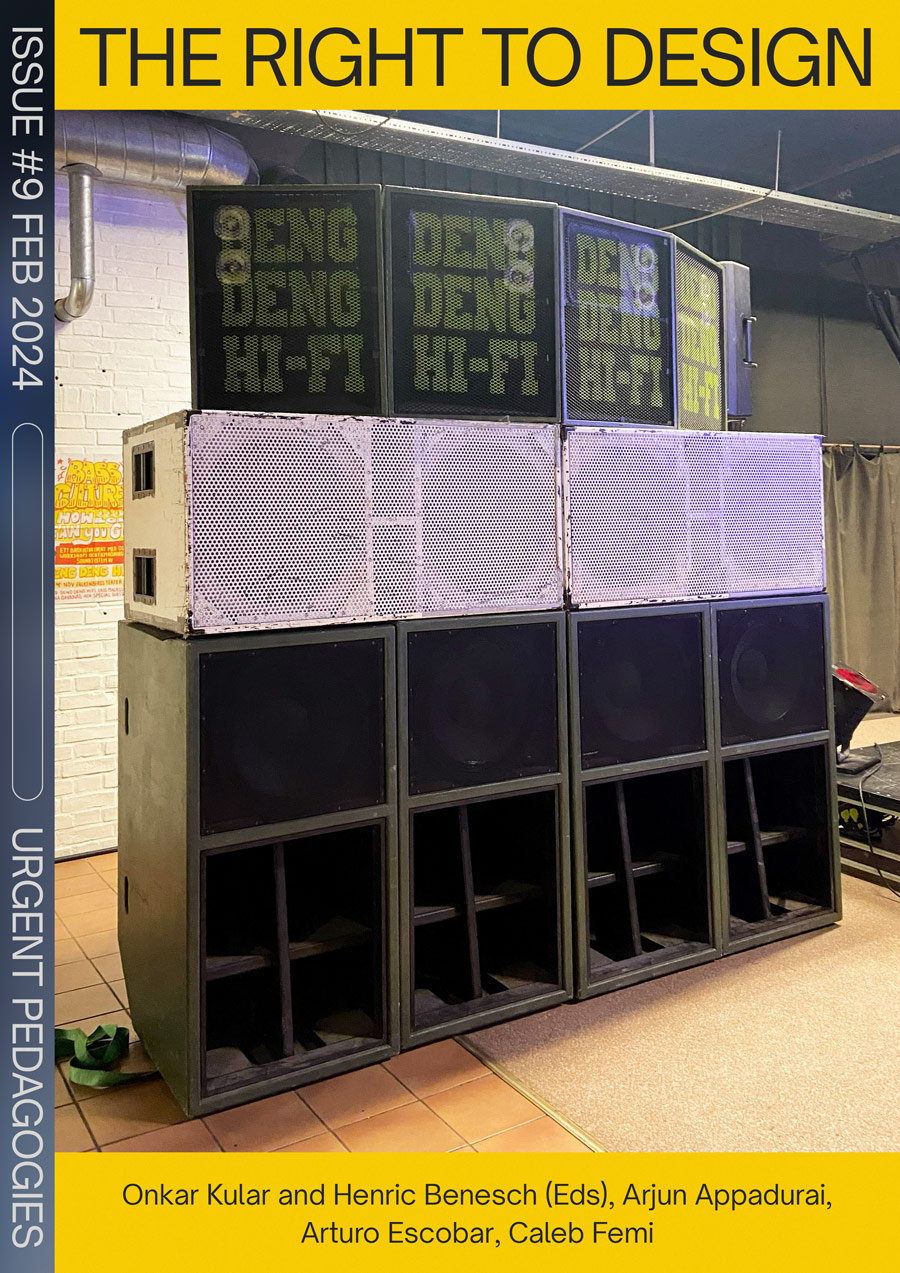A Public Design Broadcast
Bass Cultures, How Low Can You!
CATEGORY
A Public Design Broadcast outlines the programme and additional framing texts for a two-day sonic event with film screenings, workshops, talks, and DJ sets situating Bass Cultures and Sound Systems as sites for autonomous designing, learning, and pedagogy.
Through various forms of social, cultural, and political exclusions, bass music such as Reggae, Dub, Techno, Jungle, Grime has continuously produced material cultures through self-sufficient modes of designing and making. In their own unique way, these material cultures have left traces in landscapes and memory that have been largely ignored by mainstream architecture and design history. During a residency with Art Inside Out, we formulated the idea of A Public Design Broadcast, which we see as a practice of uncovering, recentering and communicating how bass cultures have designed objects, shaped spaces, and remapped places from the underground. Through the support of Art Inside Out and Smedjan, Falkenbergs Teater, Bass Cultures, How Low Can You Go! was a public programme that brought together musicians, makers, and listeners that have played an important role in bass culture in Sweden. And through the generosity of Deng Deng Hifi, we were able to use their sound system as a social and pedagogical device for gathering—allowing the opportunity to share and learn through speaking, singing, feeling, playing, and listening together.
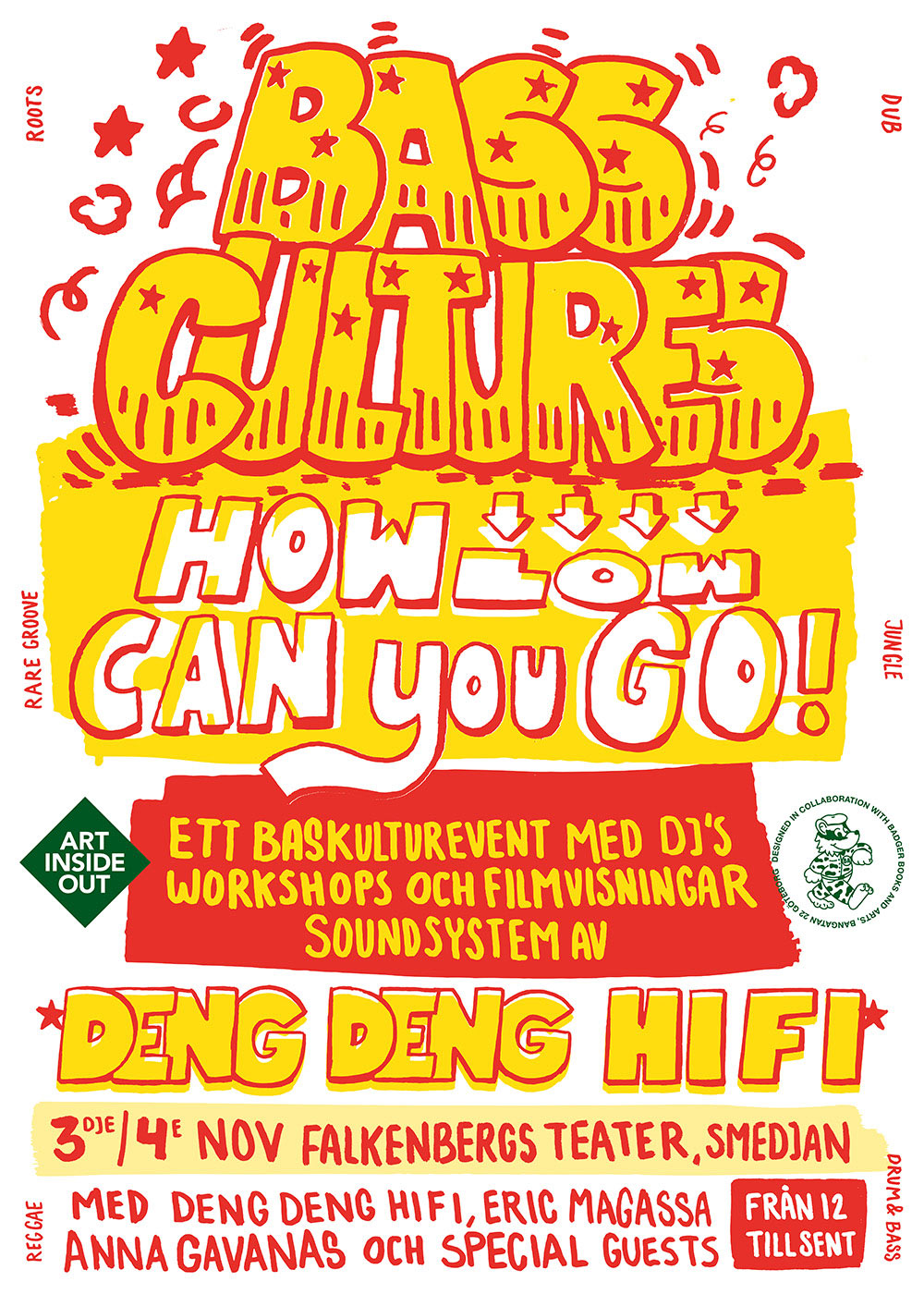
Event Poster designed by Badger Books & Art, 2023. Badger Books & Art is a publishing platform based in Gothenburg commissioning, documenting, and printing material on underground musical cultures.
Bass Cultures, How Low Can You Go! Falkenbergs teater, Smedjan, 3rd & 4th November, 2023
Through the making of sound systems, bass cultures have been important in the development of underground musical genres from Reggae, Dub and Ska to Hip-Hop, Techno, Jungle, and many more. Bass Cultures, How Low Can You Go! was a program of events supported by musicians, DJs, and makers that in their own way have contributed and played an important role in the development of bass culture, through the making of sound systems, the organising of underground music, and club culture in Sweden and beyond.
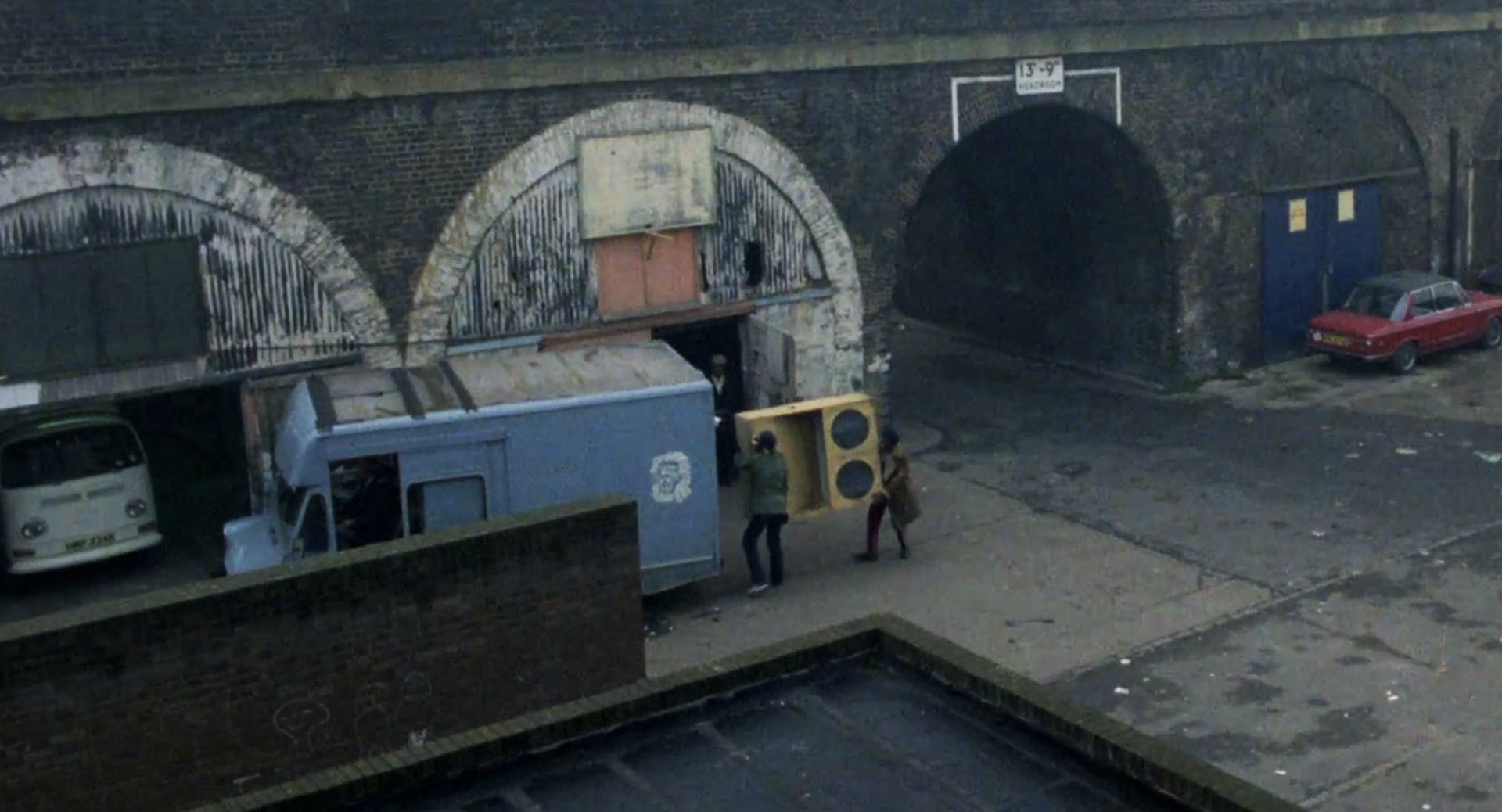
Screenshot from Babylon, Directed by Franco Rosso (1980)
12.00 BABYLON, 1980 (FILM SCREENING)
Bass Cultures, How Low Can You Go! began with the screening of the seminal bass culture film Babylon, directed by Franco Rosso and sound tracked by the legendary producer Dennis Bovell. The film follows members of the Ital Lion sound system as they prepare for a reggae dance and sound clash. Ital Lion acts as the beating heart of the film not only to foreground sound system cultures, but to vividly portray young black lives pushing back against racism and xenophobia of late 1970’s Great Britain.
There are two scenes within Babylon that acted as a red thread for the event and for our research. The first is the beginning of the film—where the crew from the Ital Lion are loading a van with speakers and equipment to be transported to a dance and sound-clash. Here we were interested in foregrounding the relationship between bass cultures and mobility—both through transportation and various spatial practices such as negotiating and designing space. The second scene is connected to one of the film’s main character Beefy, and a brilliant book essay. Beefy’s Tune (Dean Blunt Edit), written by Dhanveer Singh Brar, situates the sound system as not only a technical device that maintains and holds relations, but also as a pedagogical instrument, a site of both learning and study.
The following is an edited section of the text that was used to introduce the film within the programme. It is worth quoting at length:
“The secret to Babylon lies in its use of the Ital Lion sound system as the structuring pulse of the film. The sound system is the social device ensuring that all the central characters are entangled together. It means that as a unit they can go about making and remaking black aesthetics on a nightly basis in South London. Thus, all of the action which appears to take place away from the sound system is more like its surrounding terrain; the narrative combination of terror, malice, humour and intimacy we see on screen can be understood as flowing back into the speakers as they remodulate social problems and human desires into a thunderous delicateness… Played by Trevor Laird, Beefy takes up a specific role within the action of Babylon. He is presented as a lovable buffoon trapped in the body of a prize-fighter, prone to fits of seemingly irrational violence… All of the work done in Babylon to present Beefy in one way is a stealth move. In a scene of heightened drama midway through the first third of the film…We learn that Beefy is something else. Gathered in their railway arch lockup, where the Ital Lion Crew keep all of their equipment… They are interrupted by a banging at the door. Inevitably it is one of the white neighbours hostile to their sociality, and in fact hostile to the very fact of their existence. The door is eventually opened to a middle-aged white woman, who steps inside:
WOMAN AT LOCK UP: I might have known, I might have known. Look at ya, look at ya, look at ya. Good for nothing. Noisy. Stinking filth. Lazy. You’re everywhere. Jungle bunnies. This was a lovely area before you came here. [Turns her attention to Ronnie, the Ital Lion crew’s white friend] And you, you should be ashamed of yourself you should. You know what you are don’t you? You’re a traitor to your kith and kin. A traitor.
RONNIE: You’re no relative of mine, lady.
WOMAN AT LOCK UP: You fuck off back to your own countries you! Jungle bunnies!
BEEFY: This is my fucking country lady! And it’s never been fucking lovely! It’s always been a fucking tip! For as long as I can remember! So don’t you fucking tell me right!
… what Beefy delivers here is not a tirade, but a lecture. It is, in fact, a type of public lecture, an educational service… The idea that Beefy’s exchange with the white woman can be understood as a considered act of critical thinking is given greater credence if it is also framed through the institutional venue in which it is delivered. To put it simply: Beefy’s lecture functions as such because the sound system already configures itself as a pedagogical instrument. As much as sound systems are involved in an aesthetic experimentation with sound waves, they are also designed for learning and teaching. This occurs in multiple ways. Organisationally, the sound system crew is a school, whereby junior members are recruited, gain greater responsibility as they observe the work of others, and acquire new skills (whether technical or performative). Alongside this, a sound system is always involved in practices of dialogic knowledge production with its dancefloor. Such analysis—usually issued through the MC/ toaster—regularly enters into and rearranges the contours of the sociological, the historical, and the political. Evidence of the pedagogical imperative can be found in the proliferation of the moniker ‘professor’ among dub producers, and the number of sound systems which refer to themselves as universities. Considered in this light, it’s easy to see that what Beefy is doing is attempting to teach—as well as admonish—the white woman. He is trying to get her to learn something she appears unable to accept.”
—Brar, Dhanveer Singh. 2020. Beefy's Tune (Dean Blunt Edit). London: 87 Press
To replicate the spatial and collective movements of the opening scene of the film, following the screening, guests were invited to support Deng Deng HiFi in unloading equipment from their van and help set-up the sound system for the event.
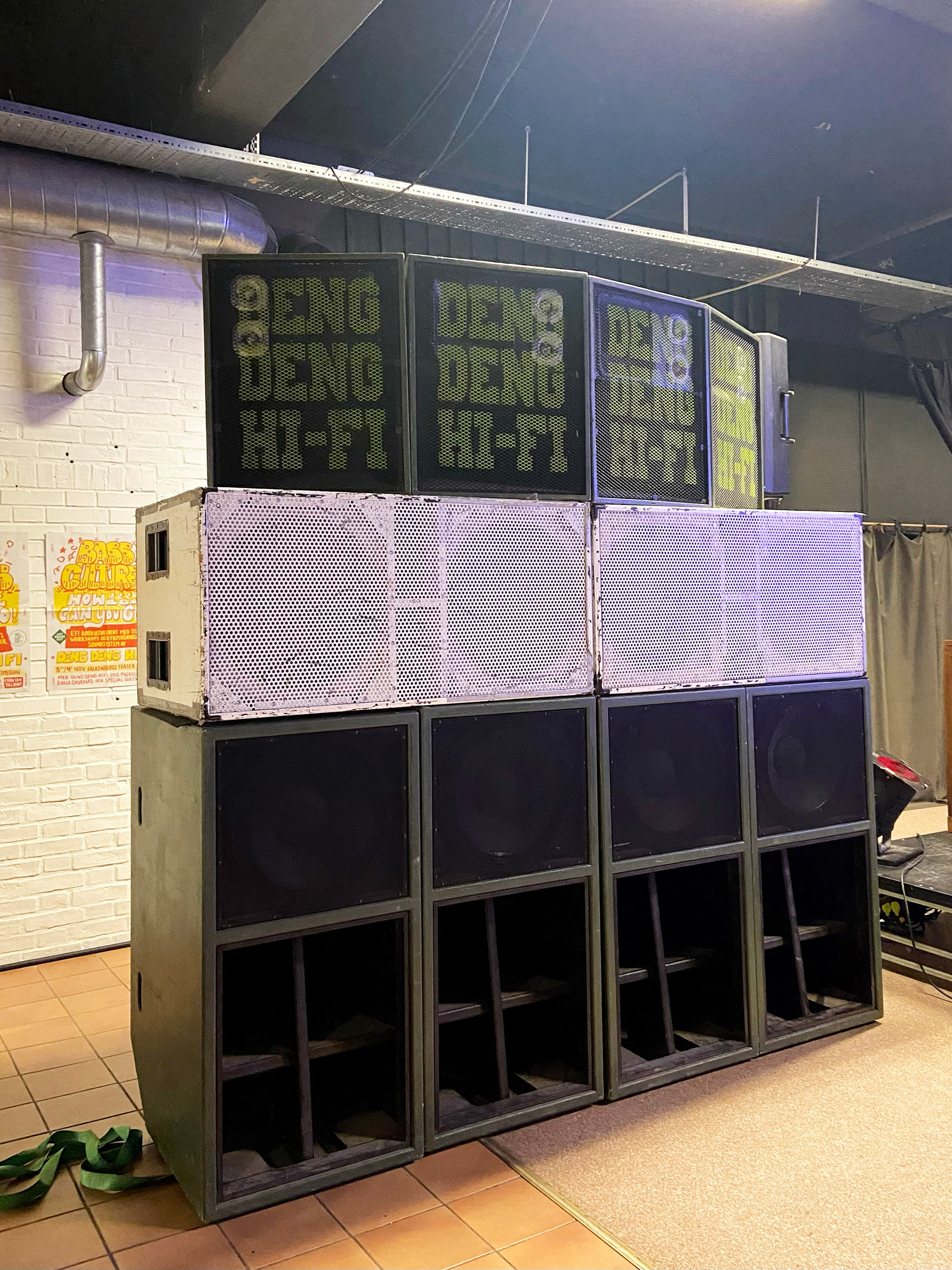
Sound System by Deng Deng Hifi, Bass Cultures, How Low Can You! Falkenbergs teater, Smedjan 2023 Photo: Onkar Kular
Many have described the making, testing, setting up and playing of Sound Systems as ‘universities of sound’. With knowledge developed over many years and generations passed on through affiliations to particular Sounds Systems and through informal apprenticeships. The following are the specifications of the Deng Deng HiFi sound system used during the event:
Four 18-inch super scoops as subs, running at 6000 watts together.
Two double 18-inch reflex boxes as kicks, running at 5000 watts together.
Four MT121 mids with horns and bullets running at 3000 watts together.
Record player and all effects, microphone and sirens were connected into a Jah Tubbys preamp, which works as a mixer and active crossover. It separates the signals into 5 different amplifiers, both analog and digital, which are then connected to the speakers.
16.30 EPA SOUNDS: PLAYING THE CAR PARK
As well as having a DIY ethos, the history of bass culture and sound systems is one of mobility. Sound systems are composed of musical equipment that can be easily stored, transported, and assembled in varying locations. As sound systems have developed both musically and materially, we have seen the rise of parallel bass cultures that share making and mobility. From EPA Traktors to Raggare, Lowriders to Gearheads, automobile enthusiasts have not only creatively modified cars but built impressive sound systems that test the limits of low frequency bass. Outside of resourced cities these moving sound systems have become important public spaces for displaying, listening, and socialising whilst driving and stationary—usually in public car parks. For this event we invited EPA Traktor enthusiasts to park in the Smedjan car park and to play their sound systems.
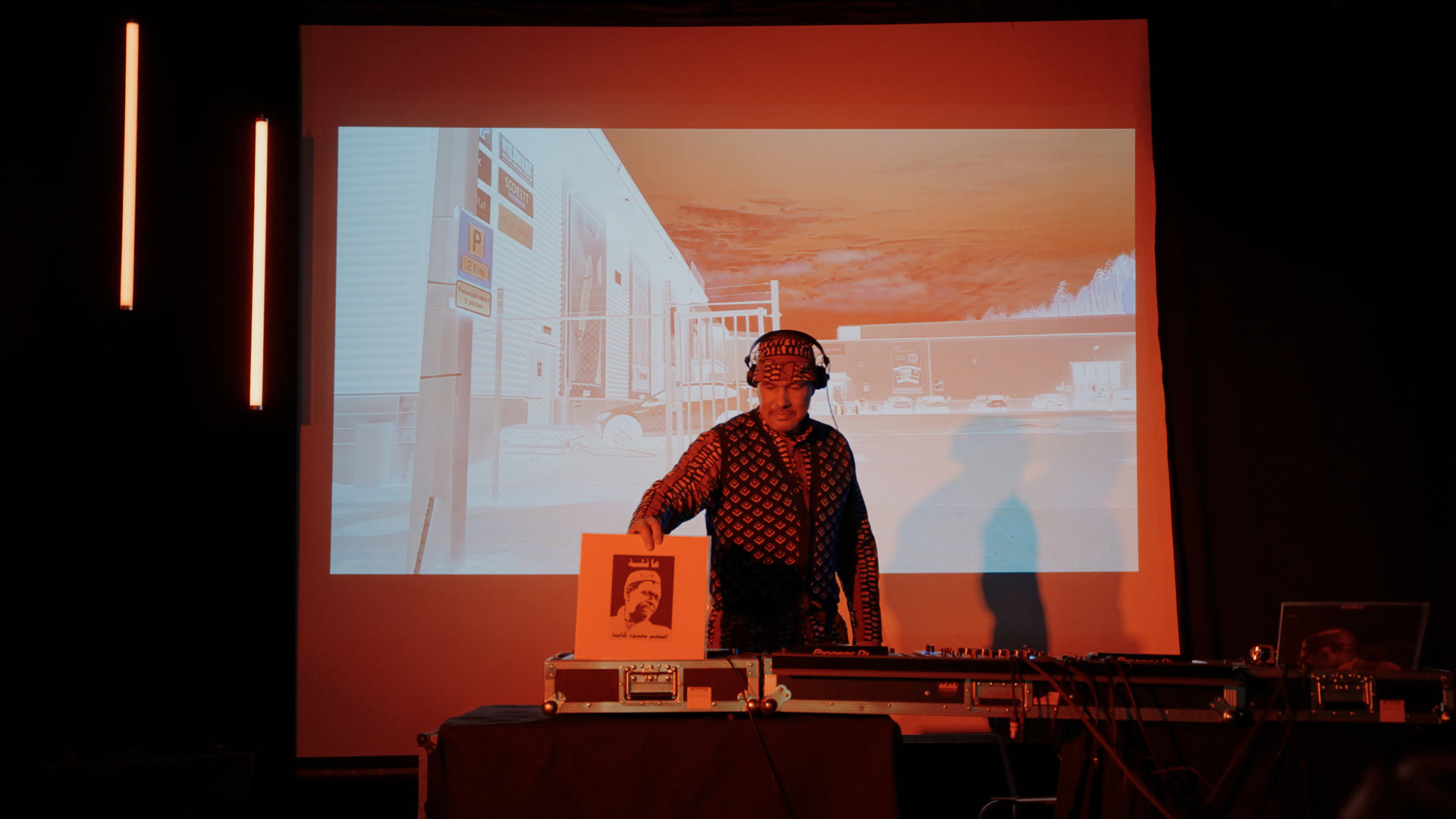
Sonic Essay by Eric Magassa, Bass Cultures, How Low Can You! Falkenbergs teater, Smedjan 2023 Photo: Joel Nilsson
18.00 SONIC ESSAY BY ERIC MAGASSA
Cars are moving sound systems; they allow for sound to be played and they produce environmental sound when they drive. At the same time, cars become a vehicle for not only transportation but for reading and making sense of spaces and places whilst driving. Berry Gordy, founder of Motown Records in Detroit, famously claimed that Motown recordings were mixed to sound good on car radios and inspired by the city’s car industry. More recently, Dr. Dre has said that heavy bass sound systems combined with the amount of driving time required by living in Los Angeles was influential to the Dr. Dre production sound. The subsequent demise of the automobile industry also provided the backdrop to the birth and sound of Detroit Techno and its assembly lines. Influenced by Techno, the electronic music artist Burial developed what he described as the ‘Car-Test’ to loop bass and electronic sounds back into urban environments.
When an electric car drives above 30 km/h, it sounds similar to a petrol-driven vehicle, as the noise is emitted from the tyres vibrating against the road rather than the engine itself. However, below that speed, it becomes barely audible. Both the interior and exterior sounds of an electric car are manufactured or ‘produced’ if we are to take the musical analogy. In one way, when we start an electric car, we are metaphorically putting a needle on a record—we might even describe the electric car as a moving record that we inhabit.
Following the idea of the car test, the artist and bass music enthusiast Eric Magassa was invited to play a sonic essay responding to a drive through Falkenberg in an electric vehicle.
The day-long drive included a visit to Falkenberg’s coastal strip and holiday cabins, passing through the Lantmännen Silo and other industrial infrastructure of the area. There were site visits to Tegelmöllan, a brick recycling facility, Grimeton world heritage site built in the 1920s to broadcast longwave radio across the Atlantic, and a visit to Gekås Ullared mega shopping centre—one of the areas most visited tourist locations.

Residency Artwork of Grimeton Radio Station 2023, Image: Onkar Kular
20.00 DUB FEELING (DJ-SET)
Sound systems are built to play bass heavy music, they are designed, engineered and spatialised to allow audiences not only to hear, but to feel music by immersing the body in low-frequency bass. Sound systems also consist of crews, who not only design and build equipment, but also develop skilled techniques through playing records and MCing. Deng Deng HiFi specially installed their sound system at Smedjan and carefully selected tracks from late 60s ska and rocksteady up until today’s dub and steppers. As they outlined, their bass heavy selection is a ‘conscious music with a clear message. No slackness or glorification of violence or degrading of women. Only good vibes and upliftment of the people.’
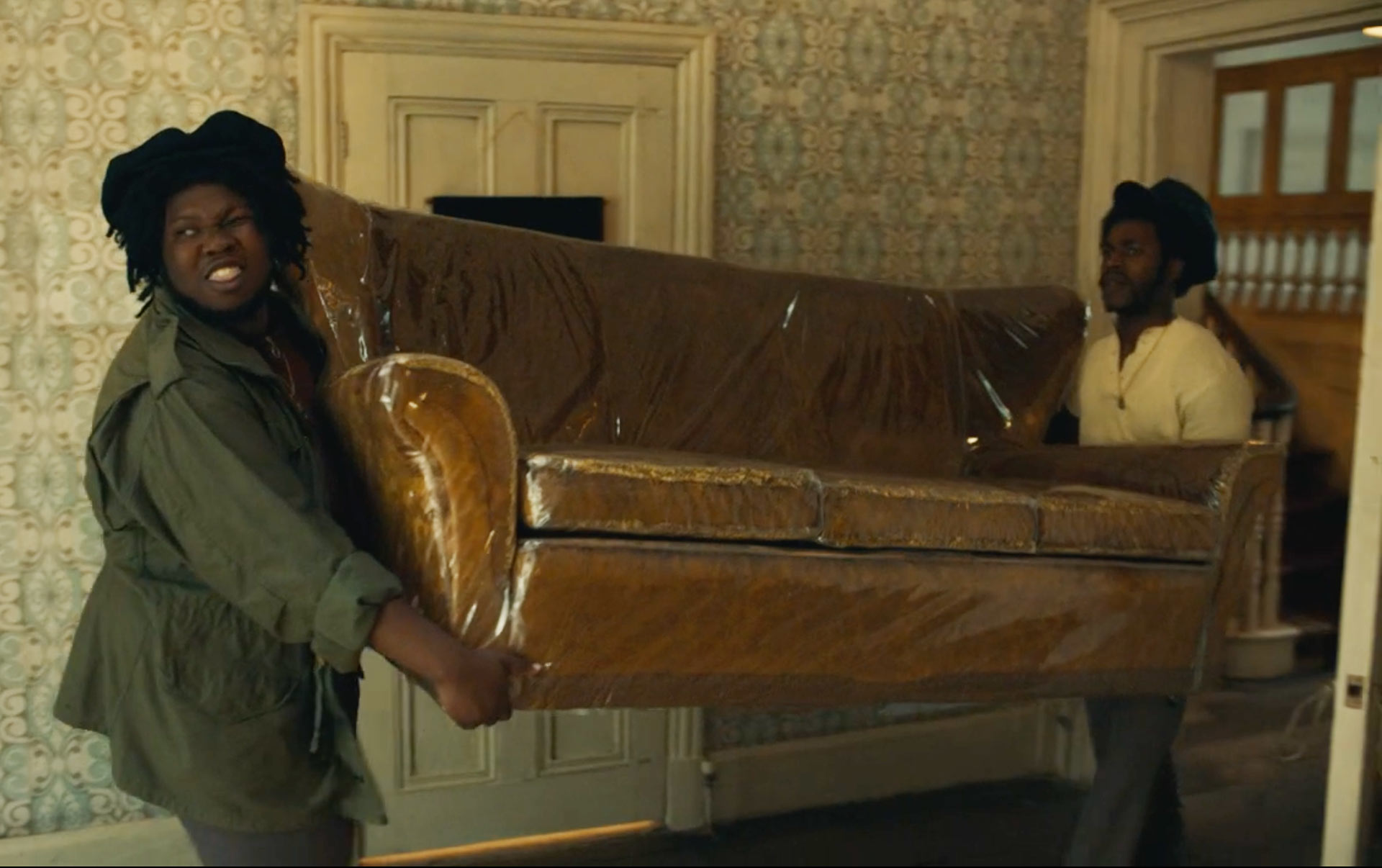
Screenshot from Lovers Rock, Directed by Steve McQueen (2020)
12.00 LOVERS ROCK, 2020 (FILM SCREENING)
As seen in the re-use of industrial spaces in Techno and Rave scenes, bass cultures have a long history of being creative with finding and making space. From the 1950s, people of colour in the UK were excluded from bars and clubs where they might listen and dance to music. This led to the creation of the blues party, a tradition that began in the West Indies, where black people could meet, eat, and dance together. To run a blues party in the UK, organisers would clear out furniture from a domestic house, set up a sound system, dance, and offer Caribbean food to guests paying a small entrance fee. Directed by the artist and filmmaker Steve McQueen and located in early 80s West London, Lovers Rock visually and sonically captures the importance of community in this space making activity.
“Sometimes there were no venues for us to play. We would go and create a venue. Meaning we would go find a derelict house, lick [sic] down the door and go inside and string up the electricity from the street and we would create the place where we could invite the public.”[1]
—Clive Allick
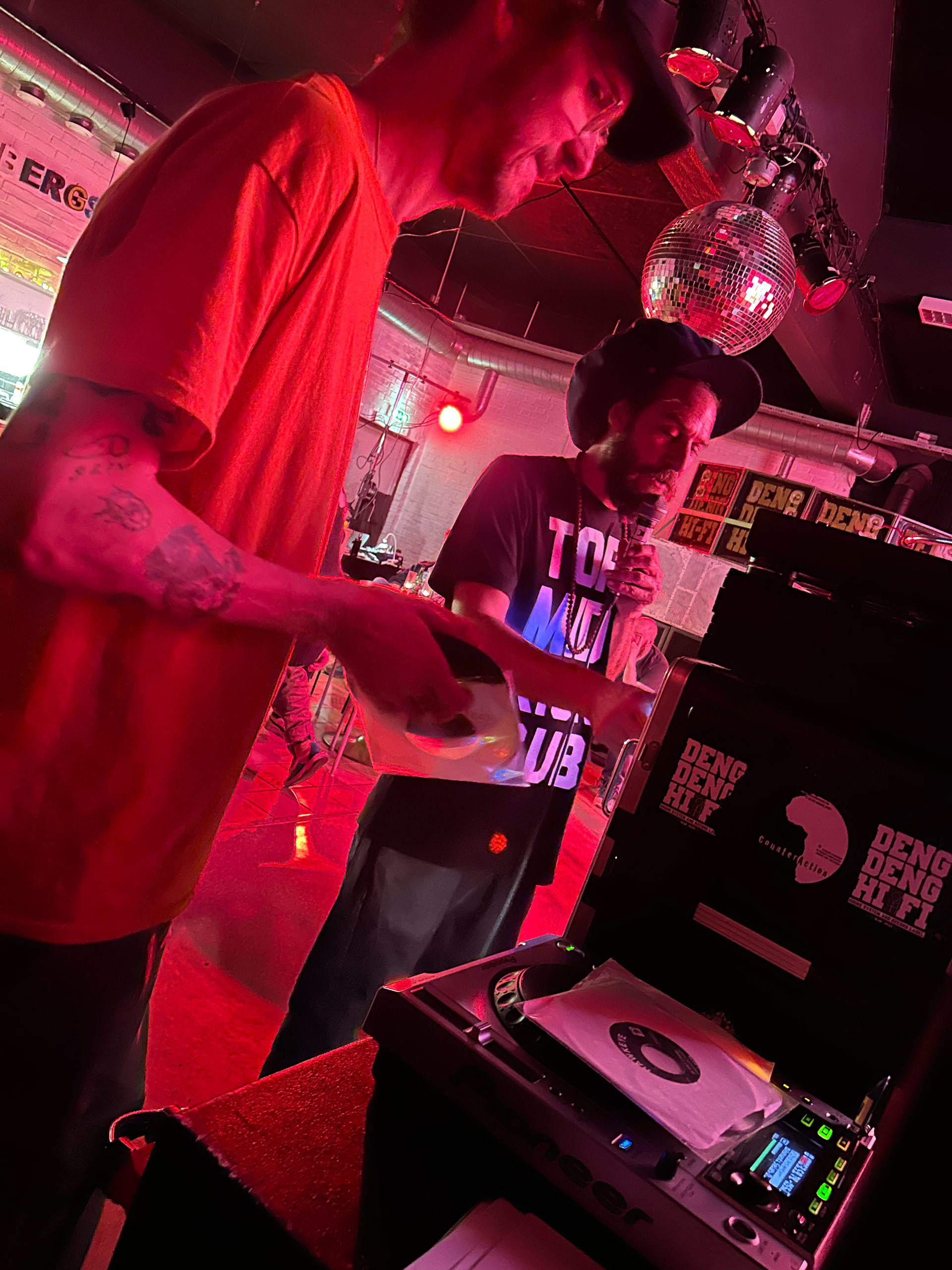
Danny Locks of Deng Deng Hifi, Bass Cultures, How Low Can You! Falkenbergs teater, Smedjan 2023 Photo: Joel Nilsson
14.00 CALLING ALL MC’s (WORKSHOP)
From Reggae to Jungle, Dubstep to Grime, central to the transmission of live bass music has been that of the MC, also known as Deejay. MCing is an artform that goes beyond the simple introduction of records. The MC acts as the main bridge between the sound system and its audience, through improvisation and translation of the ethos and values of the sound system and its crew. For this workshop, the crew from Deng Deng HiFi introduced the role of MCing in sound systems, showing different styles and how to convey conscious messages through this oral tradition. This was a hands-on (or voice-on) workshop where participants had the opportunity to test out different ways to MC, to communicate and to create a vibe.
“Well out of that now, into this–sounds of the Lucky Spin, believer! Along with the MC OC, along with the full studio crew. Heh heh heh heh, lively business! Echo?! Hah hah! Here we go now, shout going out to Rattle, you know the koo. Cooked food, love it to the bone! To the marrow! Normality, believe! L-I-V-E and direct, to the koo. Are you ready, wind your waist crew? Are you ready, headnodding crew? And those who’s driving around Don-land North East South and West, we’ve got you locked!!! Come again! Sounds of the Lucky Spin, sounds of the Stevie Hill–to all massives, all crew. A shout going out to Jim and Emma… Jim and Emma, get out of John’s bed, right here, right now–the sounds of the Don will show you how. C’mon! Do-it-like-this! 10- 57, get on the case, for the hardcore, hardcore bass. For ya face–100 percent bass! Alright, red-eye crew, you know the koo. Going out to you, wind your waist crew…. headnodding crew….and those who’s l-l-l-lickin’ it in Don- land in their cars, yes, driving about Don-land, the Don-ites and your Don-‘eads. Do-it-like-this, jungalist! Believe me, ‘ardkore’s firing!”
—MC OC on Don FM, 1993
15.00 IN THE MIX (WORKSHOP)
Bass cultures in all forms have traditionally been male dominated spaces, and even though women have been central to the development and support of sound systems and bass music their roles have often been trivialised and in many cases erased. Due to the important work of female DJs, scholars and organisers, in recent years there has been a prominent rise in female DJs, producers and sound system leaders albeit with much work to do. Over the last years, DJ and organiser Paula Maxa has run female only DJ workshops, not only to demystify the artform, but to show that bass cultures should be accessible to all.
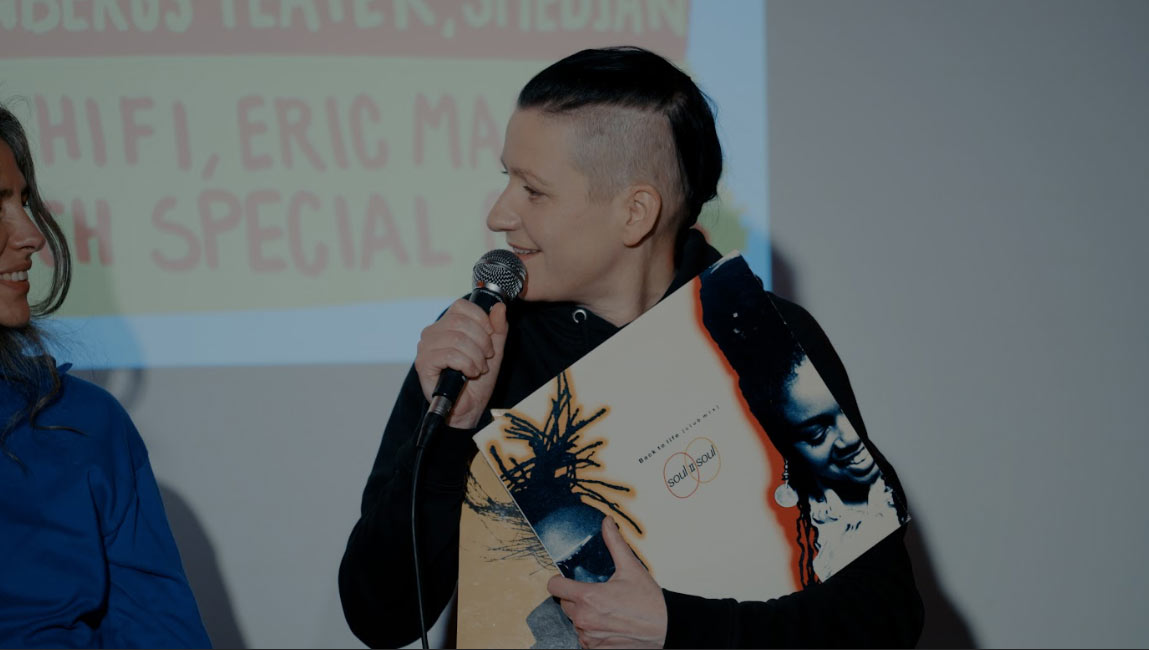
DJ and writer Anna Gavanas with Soul II Soul record, Bass Cultures, How Low Can You! Falkenbergs teater, Smedjan 2023 Photo: Joel Nilsson
17.00 BACK TO THE UNDERGROUND! (SOUNDING SPACE)
In many ways bass cultures have always been creative cultures. Whether through fashion, making of equipment, designing of graphic communications and through the music itself. Crucially, they are also about creative organising and making space for musical expression. From Reggae to Rave, Sweden has its own very rich history of making space for bass cultures that has relied on people of all backgrounds to create environments for dancing communities to be formed. In this multimedia panel session, we invited DJs and organisers that have been active in the Swedish bass scene to show, play, and discuss the importance of underground music culture in Sweden, in the past and today. For this session we were joined by the DJ and writer Anna Gavanas, singer Papa Dee and DJs Struck and Paula Maxa.
Prior to the event, Anna Gavanas shared a draft text for AIO Journal highlighting a small and historic musical venue in Gothenburg called the Funkhouse. Set up in the mid 1980s through the Afro-Scandinavian Association, the Funkhouse was not only a space to play bass music but acted as an important resource for the black community in Gothenburg. As we were hosting the event in a small cultural venue in Falkenberg, there were three aspects to Anna’s text that acted as a framework for the conversation and a way to connect back to the place that we were located within. The first was history, and why it is important to acknowledge bass cultures as broader creative cultures that expand out of the making and sharing of music. The second was space and do-it-yourself culture, focusing on the idea that outside of your bedroom, people require space to dance and listen collectively to their music, and if nobody is providing this space, you need to make it yourself. The third was around what support structures are required to form a community and how structures such as study circles and associations have enabled the forming of kinship and community.
Um, what is Soul II Soul?
Uh, well, we’re a sound system
An amalgamation of good dance music
There is, um, three of us from the north side
And two from the east
And through our style, you know
People just came to recognize us
As the funky dreads…
Yeah, we started in clubs in Soho
A little bit of pressure here and there
You know, we had our ups and downs
For everybody who can remember the Africa Centre
The centre of the world
That gave us the, um, idea to now make our own music
Creating our own styles here in London
The future? Ha, ha—the future for Soul II Soul
A happy face, a thumping bass for a loving race
Peace
—Edited lyrics from Jazzie’s Groove, Soul II Soul, Track 10 on Club Classics Vol. One
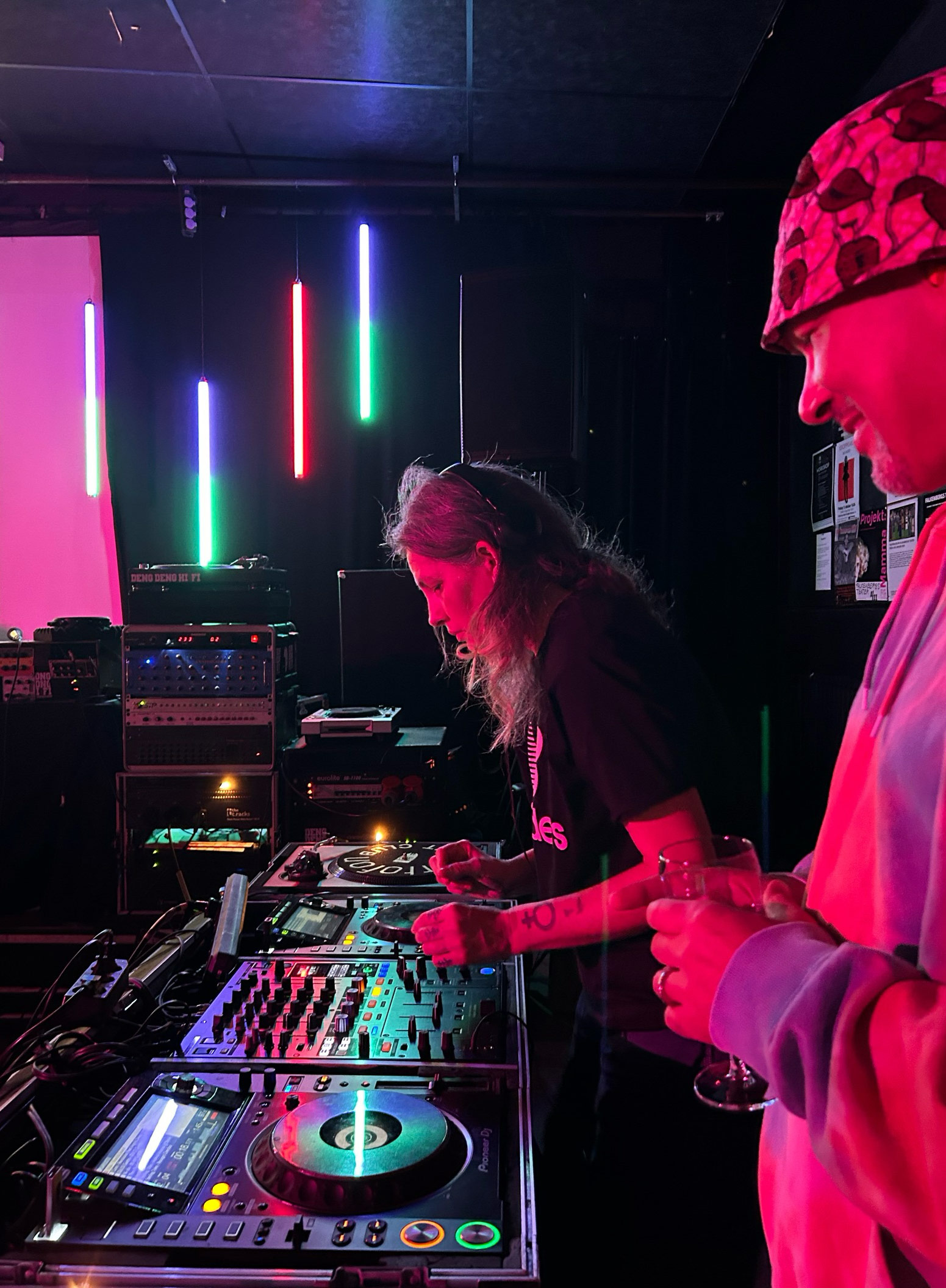
Paula Maxa & Eric Magassa, Bass Cultures, How Low Can You! Falkenbergs teater, Smedjan 2023 Photo: Joel Nilsson
20.00 PLAYING THE UNDERGROUND, FROM RARE GROOVE TO JUNGLE
Bass cultures are musically diverse, making them important to celebrate and support. They are also nuanced and contextual, with variations of musical subgenres developing within very specific regional and national geographies. The event closed with a showcasing of this musical diversity with DJ sets from guests that participated over the two-day programme. DJs included Gavanas, Aimbreak, Papa Dee, Eric Magassa, Struck, Paula Maxa, and Deng Deng HiFi.
During the closing sets, as the bass was getting lower and the building was noticeably vibrating, one of the Deng Deng HiFi crew observed that the wine glasses from behind the bar were slowly shifting towards the edge of the shelf. He proceeded to carefully tape the edge of the shelf so that the glasses would not fall onto the floor without saying a word to the bar staff. I thought how nice, like an instrument, the sound system is also a system that plays the architecture that we enclose ourselves within.
“A Public Design Broadcast” is a part of the Urgent Pedagogies Issue #9: The Right to design.
2.
Reynolds, Simon. 2008. Energy Flash: A Journey Through Rave Music and Dance Culture. London: Picador
is a sound system and record label from Malmö, founded by Dan I Locks, Jr Roots, and Chris Michael in 2005. Driven by the love of roots music, the crew have frequently played and arranged sound system events in the local area of Malmö, promoting international, as well as Swedish sound system acts, producers, and artists.
is a social anthropologist with a focus on dance music culture, working life, migration, and family politics. She has published a number of interview based and archival studies on Swedish electronic dance music scenes with a focus on technological shifts, gender, and cultural politics. Gavanas has also worked as a DJ and producer since the 1990s and onwards.
is a multidisciplinary artist, who lives and works in Gothenburg, Sweden. Combining mixed-media collage, painting, and photography, he explores issues of identity, its intermediary nature, and its connection to memories and places. Recent exhibitions include Malmö Konsthall, Malmö (2023) Marres House for Contemporary Culture, Maastricht, Netherlands (2021); Gothenburg International Biennial for Contemporary Art, GIBCA (2019); Valongo Festival, Santos, Brazil (2019); Alingsås Konsthall, Sweden (2019), and Moderna Museet Stockholm, Sweden (2018).
is a singer, rapper, and dancehall musician. He was a member of the NYC group, Brooklyn Funk Essentials, and Stonefunkers. Over the years he has released numerous albums, including solo releases. He has been a DJ, Radio host and important figure in the Swedish bass music scene.
(Paula Maxa), from Gothenburg, began DJing in 2008 and got involved quickly in the underground scene—both playing and arranging clubs. She began to hold workshops for youngsters and became active in a Soundsystem. As a teacher, Paula uses music to talk about history and society, and how these are interlinked. Paula loves to dance and make noise.
is deeply rooted in the musical underground of Gothenburg and Sweden, going through Hiphop, Acid House, Acid Jazz, Hardcore, Indiepop and more before discovering Jungle in 1994. From 1995 Struck is a member of the Laymin Soundsystem, playing Jungle, Drum & Bass, Techno and Dub at many underground parties and clubs, under different alias and in various constellations, always with a deep interest in the music and the vibe of the party. Struck is still active today organising, promoting, and DJing.
is a nomadic institution for artist-in-residence in all art forms and genres. Artists are invited to explore the possibilities for their own art practices, as well as delve into new collaborations, in the county of Halland. Through an open process that leaves room for the unforeseen, there is the opportunity for new discourses, where art generates creative solutions and new ways of seeing the world.
